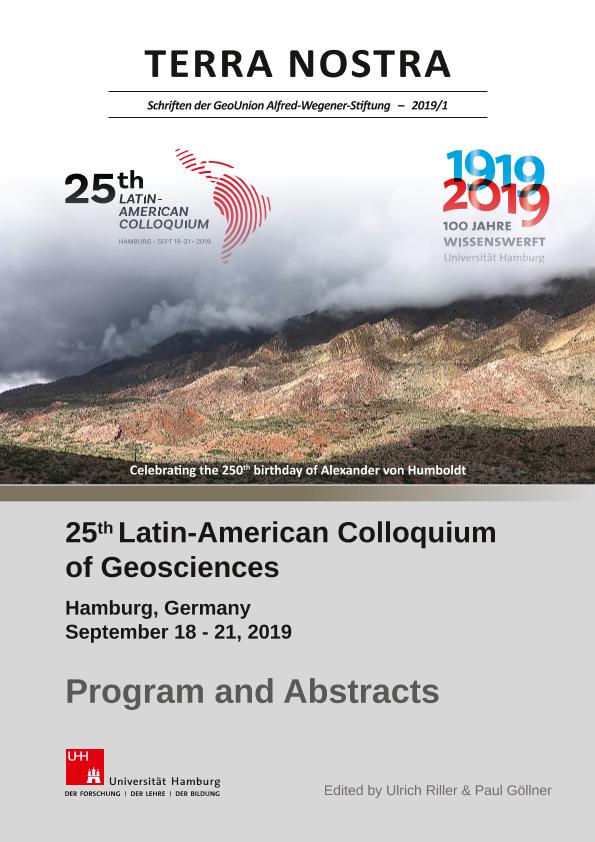Evento
Tectonic and climatic coupled processes in north patagonian andes: Miocene orographic barrier uplift and rain shadow generation
Bucher, Joaquin ; Bilmes, Andrés
; Bilmes, Andrés ; D'Elia, Leandro; López, Manuel
; D'Elia, Leandro; López, Manuel ; García, Micaela Romina
; García, Micaela Romina ; Varela, Augusto Nicolás
; Varela, Augusto Nicolás ; Franzese, Juan
; Franzese, Juan
 ; Bilmes, Andrés
; Bilmes, Andrés ; D'Elia, Leandro; López, Manuel
; D'Elia, Leandro; López, Manuel ; García, Micaela Romina
; García, Micaela Romina ; Varela, Augusto Nicolás
; Varela, Augusto Nicolás ; Franzese, Juan
; Franzese, Juan
Colaboradores:
Riller, Ullrich; Göllner, Paul
Tipo del evento:
Otro
Nombre del evento:
25th Latin-American Colloquium of Geoscience
Fecha del evento:
18/09/2019
Institución Organizadora:
Universitat Hamburg;
Título del Libro:
Abstract book- Latin American Colloquim
Título de la revista:
Terra Nostra
Editorial:
Schriften GeoUnion Alfred Wegener-Stiftung
ISSN:
0946-8978
Idioma:
Inglés
Clasificación temática:
Resumen
The relationships between climate and tectonic processes are in the geoscience spotlight during last years. The uplifting of a mountain range may constitute a topographic barrier to atmospheric circulation, thus producing the generation of an orographic rain shadow capable of driving important climatic and ecological changes. The link between these coupled tectonic and climatic processes has been analysed in several regions of the world, specifically related to the Himalaya and Andean chains uplift.As for the Andean chain, a main phase of orogenic growth occurred during the Miocene, configuring several Andean segments. Some Andean segments were widely analysed, and tectonically controlled climate changes were established. For instance, several works indicate that, during late Miocene times, the orographic uplift of the Central Andes triggered meaningful climatic changes, from wet to dryer conditions. Another Andean segments as the Southern Andes remain less understood in terms of tectonic climate interactions, and only a few semi-quantitative approaches were addressed for the past 20 Ma. In this work, we analyzed a continuous palaeosols succession recorded in a North Patagonian Miocene foreland basin in order to understand the moisture regime changes in response to the uplifting of the Patagonian Andes.Based on macromorphological, micromorphological and geochemical analysis, supported with a high-resolution time scheme, the palaeosols were characterized with their corresponding Mean Annual Paleoprecipitation (MAP) and Mean Annual Temperature (MAT) values. Alfisol-like palaeosols were identified at the base of the foreland infill (15-14.6 Ma) with MAP of 1229 ± 108 mm/yr. Andisol-like palaeosols were recognized in the middle section of the sequence (14.6-12.75 Ma) with MAP of 1056 ± 108 mm/yr, whereas Aridisol-like palaeosolslocalized at the top of the infill (12.75-11.5 Ma) presented MAP of 677 ± 108 mm/yr. Mean Annual Temperatures has not meaningfully changed since the Miocene (~11 ± 2.1°C) to the present (11°C).These data indicate a continuous decrease in MAP (greater than 600 mm/yr) and stable to slightly decrease in MAT between 15 to 11.5 Ma for the North Patagonian extra Andean region. The decrease in the rainfalls may be related to the growth and uplift of the Patagonian Andes and the rain shadow generation. The results indicate that although the Patagonian Andes started the uplift around 19 Ma, a time-delay of ~4 Myr with the rain shadow generation occurred, and the rain shadow effects were effectively recorded since ∽14.6 Ma. Therefore, during the first phase of mountain growth, the North Patagonian Andes were not high enough to generate a recordable rain shadow effect.
Palabras clave:
TECTONICS
,
OROGRAPHIC RAIN
Archivos asociados
Licencia
Identificadores
Colecciones
Eventos(CIG)
Eventos de CENTRO DE INVEST.GEOLOGICAS (I)
Eventos de CENTRO DE INVEST.GEOLOGICAS (I)
Eventos(IPGP)
Eventos de INSTITUTO PATAGONICO DE GEOLOGIA Y PALEONTOLOGIA
Eventos de INSTITUTO PATAGONICO DE GEOLOGIA Y PALEONTOLOGIA
Citación
Tectonic and climatic coupled processes in north patagonian andes: Miocene orographic barrier uplift and rain shadow generation; 25th Latin-American Colloquium of Geoscience; Hamburgo; Alemania; 2019; 34-34
Compartir



